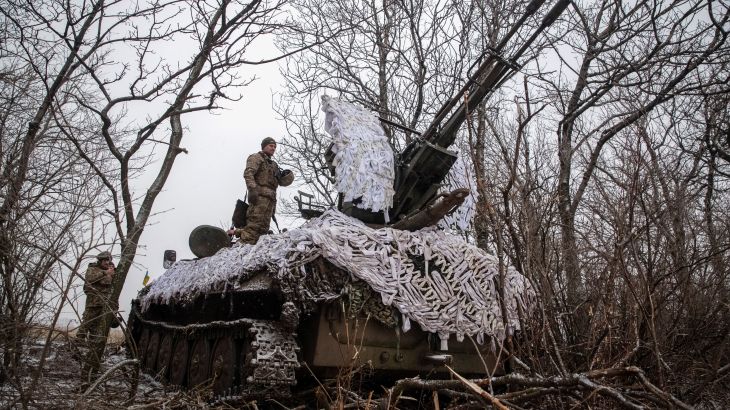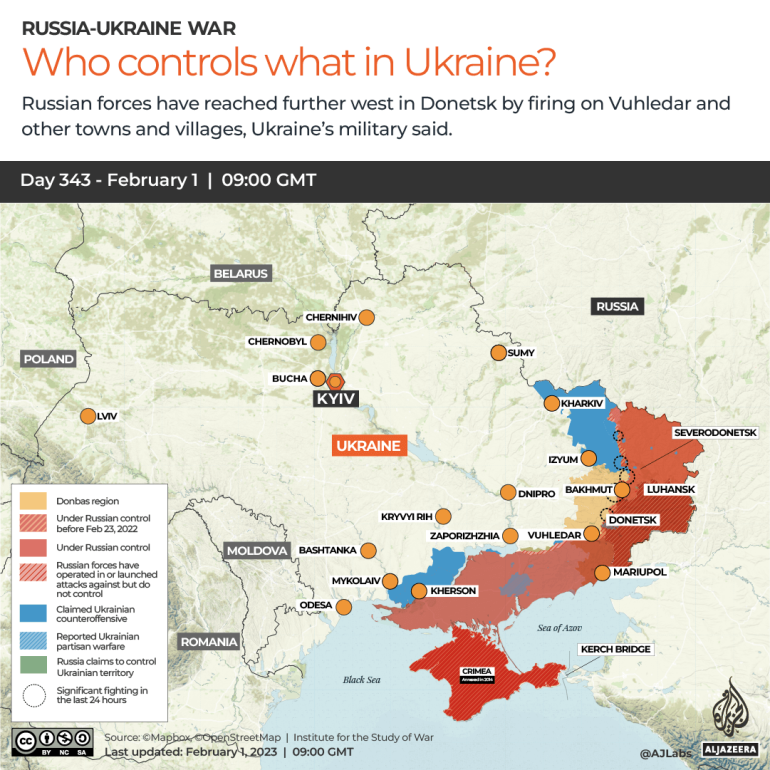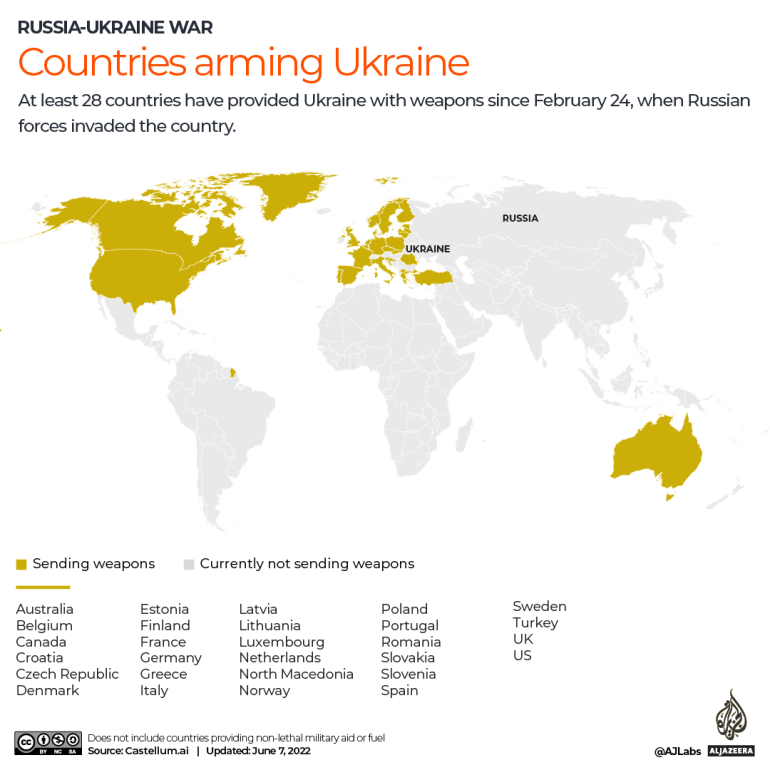Western weapon deliveries in a race against Russia offensive
Ukraine’s allies have pledged longer-range weapons and rushed to deliver tanks and armoured vehicles as Moscow intensifies its campaign in the east.

Ukraine has won new weapons pledges that will help it launch a major counteroffensive later this year, but Russia has tried to take back the initiative in the 49th week of the war.
Ukraine faced intensifying battles in the east where Russian regular troops were injecting new vigour into fronts held by mercenaries from the Wagner Group, mounting new offensives and incrementally gaining ground.
Keep reading
list of 4 itemsPhotos: Musicians fleeing Russia find a new audience in Georgia
Russia claims village near embattled Ukrainian city of Bakhmut
US readying new $2bn Ukraine weapons package: Report
The hammer has fallen hardest in the eastern city of Bakhmut, where Ukrainian unit commander Denys Yarolavskyi said “super qualified” Russian troops were pouring in during the week. Those included elite airborne troops that reportedly made marginal gains in Bakhmut on January 29 and 30.
In a single 24-hour period, Ukraine’s eastern forces spokesman Serhiy Cherevaty said on January 31 that 42 battles had taken place within 15km (9 miles) of Bakhmut in the region of Donetsk.
Russian troops launched a new battle against Vuhledar, a town 30km (19 miles) southwest of the occupied Donetsk city on January 27. Ukrainian defenders repulsed them but geolocated footage suggested they captured the village of Mykilske on the southeastern outskirts of Vuhledar.
Russian forces also conducted a reconnaissance-in-force in the neighbouring Luhansk region on January 27, breaking through Ukrainian defences near the village of Ternova.
Further north, they stepped up cross-border artillery attacks. The Ukrainian state border service said 60 explosions were heard in the Sumy and Chernihiv regions on January 26, far from the battlefront. The explosions were 120mm shells being fired from Russian territory.
And Russia continued its blitz, launching 55 air and sea-based cruise missiles and 24 Iranian drones into Ukraine on January 26. Ukraine’s air defences shot down 47 of the missiles and all 24 drones.
The surviving missiles caused no casualties but the next day, three people were killed and 14 wounded when Russian S-300 missiles struck the town of Kostyantynivka in the Donetsk region.

Weapons pledges come in
After the attack on Kostyantynivka, Ukrainian President Volodymyr Zelenskyy renewed his call for longer-range weapons.
“Ukraine needs long-range missiles, in particular, in order to remove this possibility of the occupier to place its missile launchers somewhere far from the front line and destroy Ukrainian cities with them,” Zelenskyy said.
As if in response, two United States defence officials told the Reuters news agency a forthcoming $2bn package of military aid could include some of the longer-range weapons Ukraine has been asking for.
The Ground-Launched Small Diameter Bomb (GLSDB) has a range of 150km (93 miles), double that of the high mobility artillery rocket systems (HIMARS) the US provided last June. The bombs would put all of the occupied and partly occupied Donetsk, Luhansk, Zaporizhia and Kherson regions within range of Ukrainian forces.
That is important because Russia has been learning from its mistakes and was placing ammunition depots 80-120km (50-75 miles) from the front line in the Russian region of Rostov, out of range of HIMARS rocket artillery, said Ukraine’s deputy military intelligence chief Vadym Skibitskyi.
“If you ask what’s critical for the Russian Federation, the centres of gravity are these very hubs and they need to be struck in order to disrupt the supply systems of all kinds,” Skibitskyi said.
Longer-range weapons would also help Ukraine soften Russian defence positions ahead of a counteroffensive, Skibitskyi said.
Battle tanks
Ukrainian air force spokesman Yuriy Ignat said Ukraine was to be supplied with the French-Italian Aster 30 surface-to-air missile, which also has a range of up to 150km (93 miles), in what may have been a coordinated decision with that of supplying the GLSDB.
The US has still not approved giving Ukraine the 300km (186-mile) range Army Tactical Missile Systems (ATACMS) rocket it wants.
Polish Prime Minister Mateusz Morawiecki on January 27 said Poland would give Ukraine 60 modern tanks, including a company of Leopard 2 tanks.
That brought to 119 the number of Western battle tanks allies have now pledged, including 14 Leopard 2s from Germany, 14 Challenger 2 tanks from the United Kingdom, and 31 Abrams M1 tanks from the US.
That is still far short of the 300 battle tanks Ukraine has said it needs to take back all of its occupied territories, and they may not all arrive quickly.
Valuable time – and lives – lost
Analysts have suspected for some time that Russian President Vladimir Putin is planning a significant counteroffensive and evidence of that mounted in the 49th week of the war.
Bloomberg quoted Kremlin sources as saying Putin was planning a late winter offensive to take back the initiative.
“Putin remains convinced that Russia’s larger forces and willingness to accept casualties … will allow it to prevail despite the failings so far. The renewed offensive may start as soon as February or March, the people close to the Kremlin said,” Bloomberg wrote.
Germany’s company of Leopard 2 tanks and the UK’s company of Challenger 2 tanks are scheduled to arrive in Ukraine at the end of March, while US Pentagon spokesperson Sabrina Singh said the Abrams tanks would “take months rather than weeks”.
A Russian offensive in the next two months could catch Ukrainian forces unequipped, which has led to harsh criticism of Western indecision.
The Royal United Services Institute’s ground war expert, Jack Watling, said Germany’s insistence on the US pledging Abrams tanks before it pledged Leopards lost valuable time and complicated Ukraine’s defence.
“Thanks to the obstructionism and incompetence of the German government, Ukraine has ended up with the worst of the positive outcomes available. Rather than receiving a large number of a single type of tank they are receiving three different NATO-designed tanks, all in limited numbers and each with separate, complex maintenance requirements. This will delay getting these tanks to the front lines,” Watling wrote.
Russia is using its attacks in the Donbas to draw Ukrainian soldiers into an attritional fight and hobble their ability to man a counteroffensive in the spring, Watling said.
The Institute for the Study of War (ISW) said Ukraine’s counteroffensives have depended on Western weapons deliveries and delays have weakened its defences.
“If allies had started transitioning Ukraine to Western battle tanks, aircraft and armoured vehicles in early summer 2022, the Russians would never have had the chance to regain the initiative, as they are now attempting to do,” said ISW.
If Ukraine is unequipped to launch a winter offensive, the muddy spring weather may force it to wait until early summer to do so, allowing Russia to make even more incremental territorial gains, the ISW said.

Better late than never
It appears the urgency of the situation has begun to sink in. The US Transportation Command said 60 Bradley Fighting Vehicles promised last month had already been shipped to Ukraine and posted photographs on social media showing them being loaded in Charleston, South Carolina in the US.
Allies also began to address the long-term nature of the war facing Ukraine, given Putin’s apparent intention of doubling down.
Ukraine’s general staff said France and Australia were embarking on a collaboration to produce 155mm shells for its artillery.
Ukraine’s foreign ministry said German defence manufacturer Rheinmetall was prepared to step up production of tanks and artillery to meet Ukrainian demand.
The US is increasing artillery shell production sixfold – a level not seen since the Korean War – to replenish stocks sent to Ukraine, supply Ukraine with more and build up stocks for future conflicts. According to a New York Times report, the US Army was buying 14,400 shells a month until September 2022, when it tripled that, and in January 2023 doubled it again to 90,000.
But some Ukraine allies are still drawing the line at air power. Austria and Hungary last week joined the US and Germany in refusing to pledge F-16 fighter jets.